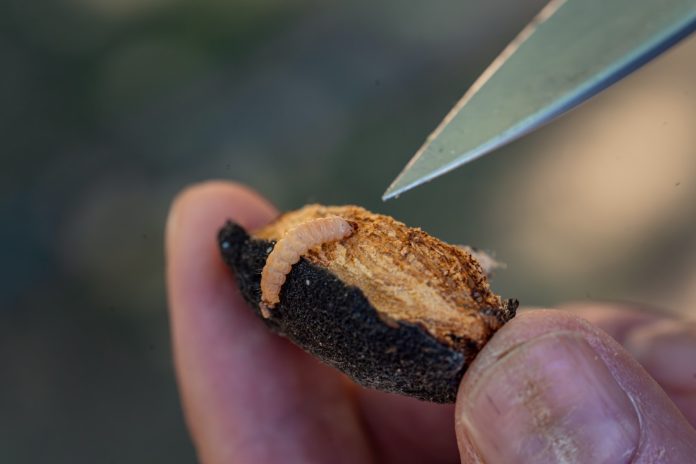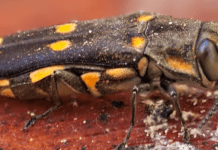
Over the past two years, California almond growers have endured perhaps the most challenging times the commodity has seen. Between unprecedented low market value, shipping troubles, and skyrocketing input costs, there simply is no room for error these days.
As the season ends, another challenge growers are having to deal with is a pest known all too well in almonds: navel orangeworm (NOW). Handlers are reporting higher-than-normal damage from NOW this season, which can be attributed to several factors, one being the lack of sanitation efforts performed last winter.
“We heard from industry last year that insect damage was rising, yet given the economic pressures growers were facing, coupled with heavy winter rains, winter sanitation was difficult,” said Tim Birmingham, director of quality assurance and industry services at Almond Board of California (ABC).
The Economic Effects of NOW
Regardless of the reason for insufficient winter sanitation efforts, the industry is seeing the impact of those decisions. Now more than ever, experts are emphasizing a thorough integrated pest management (IPM) plan to stop this upward climb of NOW infestations.
“We’re at a point where we have to pay close attention to every dollar we’re spending,” said Brittney Goodrich, assistant cooperative extension specialist at UC Davis. “It’s really important to be scrutinizing the dollars being spent on pest management practices.”
To better assess the economic impact NOW can have on a grower, Goodrich and a team at UC Davis analyzed how many applications, on average, are put on an orchard to control NOW, and associated costs. The researchers assessed 53 conventional chemical pesticide products and seven mating disruption products and applied these products during the time that NOW would be an issue.
It was found on average statewide, 1.4 applications of pesticides are put on each acre to treat NOW; however, this varies depending on geographic location. For example, in Placer County where almonds are fewer in number, the application was 0.2 per acre, whereas in Fresno County, it was 2.0 per acre.
In terms of cost per acre, the statewide average totaled $99 per acre, which includes the application cost and mating disruption cost when used. Again, there is variation depending on the country, with Placer County costing $8 per acre and Fresno County costing $146 per acre.
This year’s harvest is proof there is an obvious need for more resources to help growers assess the economic impact of various IPM practices, which is why UC Davis is piloting the NOW IPM Program Comparison Decision Tool.
This tool allows growers to plug in combinations of various IPM programs and assess which will work best for their specific operation. In an example presented by Goodrich, she compared Program 1, which included winter sanitation, pesticide application in the spring and pesticide application at hull split to Program 2, which consisted of a winter sanitation, mating disruption and pesticide application at hull split.
This decision tool showed reject percentages were the same between the two programs, although there was a price loss difference of $35 per acre from Program 2.
The tool also gives insight into what a grower’s breakeven would be, considering damage percentages, input costs and market prices for almonds.
“This shows you what we should be considering when we’re making these decisions,” Goodrich said. “A lot of times, we only think, ‘Mating disruption is really costly; it’s really hard to fork out that extra money,’ but if it is going to result in lower damage rates, it might be a net benefit to employ some of these more costly pest management methods.”
Losses from NOW
Perhaps one of the trickiest characteristics about NOW is the impacts are not fully exposed until after harvest. Mel Machado, vice president, grower relations at Blue Diamond Growers, said at the processing level, losses from NOW are not only seen in premium values but also in weight.
Machado warned even though these losses are shown on the processing statement, they don’t always tell the full story. Growers now are seeing even more rejection at the huller/sheller level because many processors have implemented color sorter technology that picks through nuts even more closely.
“For navel orangeworm actual losses, you can figure it’s double what you’re seeing on the statement because the real light stuff is getting blown out at the harvest,” he said.
On more infectious years like this year, Machado said he has seen growers who usually never have problems with damage experience 8% to 12% rejects once harvest is wrapped up, costing them potentially thousands of dollars per acre.
Destroying Mummies
The only way to ensure there are no surprises by the time harvest comes is to invest in proper winter sanitation practices like removing and destroying mummy nuts. This ensures NOW do not have the opportunity to survive into the spring season and infect the future crop.

It is well known in the industry that mummies left after harvest have a direct correlation with NOW. Justin Nay, president and CEO of Integral Ag, Inc., has been sampling mummy nuts for NOW larvae for over 15 years. He said in 2022, the average number of larvae found in the mummies they inspected was the third highest they have seen, with 27 larvae per 100 mummies. That number is expected to grow this year, given 2023 conditions, which is why Nay stresses the importance of an IPM plan.
“The January 2023 Almond Position Report showed a 2.02% Nonpareil reject number,” Nay said. “That roughly comes out to 100 to 150 females per acre. It’s a reasonable assessment that we’re not sanitizing enough to keep those numbers below 2% to get our premiums.”
Subsequently, NOW infestation triggered by mummy nuts also opens the door to further threats to the industry like aflatoxins. Aflatoxins are a food safety contaminant and a major concern for exporters, Birmingham said. The industry does not want to get into a position where trade partners are concerned with the quality of California almonds over a matter that can be, in large part, prevented.
“Basically, European authorities closely watch the rejection rates; the more rejections they have, the more they will test for aflatoxin,” Birmingham said. “Even though we have a very robust protocol, every time a container is sampled and tested, there is a risk. The more they recognize the California industry understands the concern and is addressing it, the more confidence they have in our system.”
Looking Ahead
The good news is the industry is in a position to stop this cycle. The 2022 and 2023 harvests have provided a great learning lesson for many growers in the industry, and this winter it is encouraged that orchards are sanitized through and through to ensure solid protection against NOW that lasts year-round.
The Almond Board of California recommends consulting with your PCA to see what the best plan of action is for your winter sanitation program.










